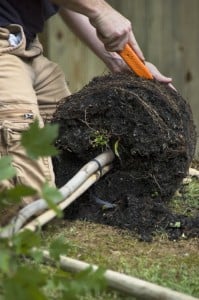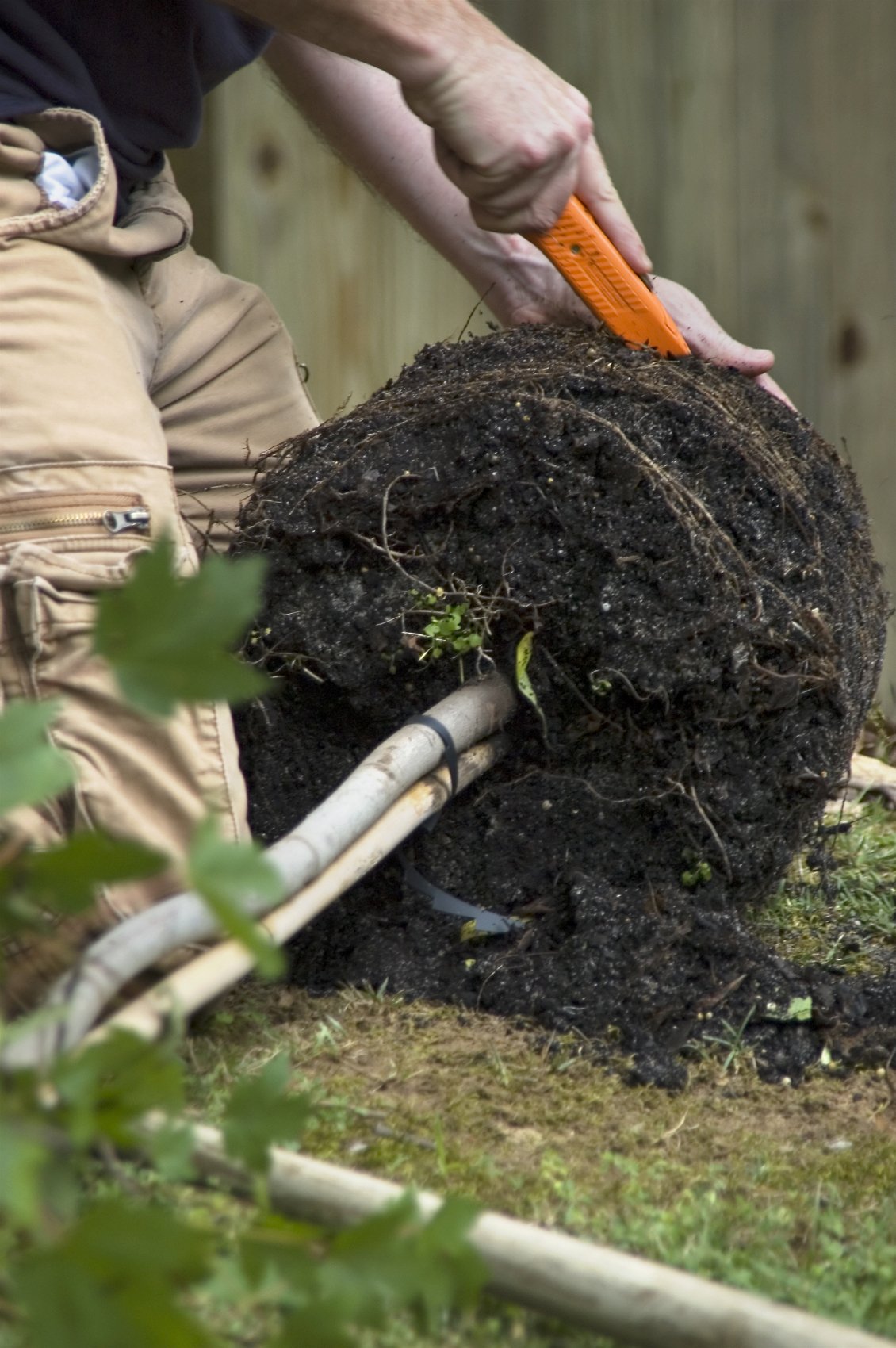 A root ball is the main mass of roots located at the base of a plant. Root balls are particularly important when transplanting a tree to or from a pot. The size, quality and actual preparation of the root ball directly impacts if the tree will survive and flourish. The root ball includes the actual string of roots, as well as surrounding dirt and soil. If the root ball is damaged during transplant the plant may never recover. It’s very important to treat the root ball delicately and with great care.
A root ball is the main mass of roots located at the base of a plant. Root balls are particularly important when transplanting a tree to or from a pot. The size, quality and actual preparation of the root ball directly impacts if the tree will survive and flourish. The root ball includes the actual string of roots, as well as surrounding dirt and soil. If the root ball is damaged during transplant the plant may never recover. It’s very important to treat the root ball delicately and with great care.
How To Properly Transplant Plants And Trees With Large Root Balls
Big or small, the root ball is an important part of the plant that you don’t want to damage when transplanting from one location to another. Here are some simple instructions to help you re-plant a tree without damaging the root ball.
- Create a space in the new soil by prepping soil and digging out a hole with slopped sides for the root ball and plant to fit in. If the plant is from a local nursery, make sure the hole is at least 3 to 4 times wider than the plastic container the plant is currently housed in.
- Remove the plant from the container very carefully; you want to keep all of the surrounding soil protecting the fragile root ball in place. Try knocking on the sides of the container to help loosen it as opposed to yanking it straight out.
- Trees grown in a container are prone to becoming root bound, meaning the roots are going up and around the root ball in a tangled upside-down mess. If this is the case use a sharp knife to cute an X at the bottom of the root ball, along with four vertical slices on each side of the root ball.
- Gently place the plant at the center of the hole you have dug out, either in a larger planter or in the ground. Avoid planting too deep by making sure the root flare at the base of the trunk is just above ground level.
- Use the proper soil to secure the tree in place so that it is sitting upright in the correct position. Pack the entire hole or pot with soil, some plants prefer loosely packed soil and others prefer tightly packed. Know what your plant prefers and then deliver that. Backfill until the soil reaches the root collar, or just below.
- Give the tree plenty of water, allowing it to sink into the soil. Once water soaks in, spread protective mulch 3-feet around the diameter of the tree, and about 2-4 inches deep. Make sure the mulch does not touch the base of the tree or the actual plant.
What Causes A Plant To Go Root Bound?
When you purchase a plant grown in a container it has likely spent a good amount of time in this pot. Here, it has grown, and grown so more. When the roots run out of room to grow down, they start to look for other ways to grow. When you remove a plant with roots encasing the root ball you are looking at a root bound plant. With nowhere else to go, the roots grow up and around the actual root ball.
It is a common mistake to simply resoil a plant still root bound, and it’s easy to understand why this mistake is often made. After all, you are taught roots are sensitive and it seems harsh and potentially damaging to yank the roots down. The thing is, if you plant something that is root bound it will remain like this and continue to grow in an abnormal circle. By unbinding the roots you give them a chance to grow down deep into the soil to create a firm base to anchor the plant as it further grows and develops. The best thing you can do for a root bound plant is shake out its roots before replanting it. (Learn More)
How To Loosen Root Ball, or “Tickle the Roots”
In most cases, the roots can be loosened using your fingers. In extreme cases you will want to reference the trick with the knife cutter mentioned above. By cutting a slice out of the bottom of the root ball with a sharp knife or pruners you allow the roots a chance to grow down. Make sure and slice through several spots around the root ball in order to promote root growth in every direction. This practice is also known as tickling the roots.
You never want to loosen a plant’s roots if you are not immediately ready to replant it. Have your new pot or plant location prepared and ready to go before ever cutting or tickling the roots. (Reference)
What About Root Pruning?
If a large established tree is replanted and moved from an in-ground location the roots are likely very deep and extensive. Root pruning describes the process used to sever the roots of a tree before it is removed and relocated.
After years of growth the roots of a tree reach far beyond the actual feeder roots that supply the tree with food and nutrients. When a tree is transplanted all you need is the root ball with the intact feeder roots. Root pruning involves severing the tree at or near the drip line, and is done before the tree is relocated in order to promote the development of new feeder roots. If root pruning is conducted a solid year before transplanting the tree, this gives the tree enough time to recover from the stress, regrow new feeder roots, and be healthy for transplantation with a much more manageable root ball.
A plant cannot withstand having its precious roots destroyed and then planted in a foreign environment; it’s all too much stress for an ordinary plant to handle. This is why it’s so important to give the tree time to recover in its known environment before transplanting it.
If you don’t have an entire year to wait, 2-3 months is the earliest you should try and move the tree post root pruning. Root pruning can also be used to slow the growth of a tree.

